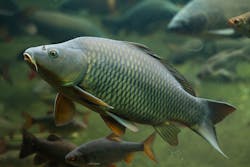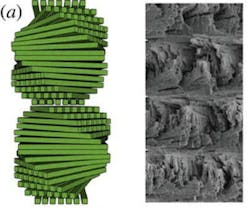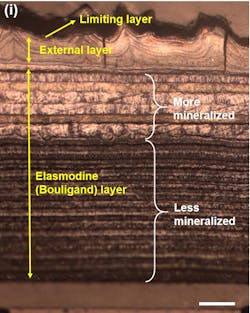Material engineers and scientists at Lawrence Berkley National Laboratory were intrigued by how flexible, yet durable, fish scales are. They knew from marine biologists that fish scales have a hard outer shell with a softer inner layer, and they are tough and ductile. When predator’s teeth try to sink into the scales, the outer shell resists penetration but the inner must absorb the excess load to keep the scales in one piece.
To determine how fish scales imaged to handle the impacts and stress, the Livermore team used X-ray imaging techniques to examine and observe carp scales down to the nanoscale.
The researchers used powerful X-ray beams at Berkeley Lab’s Advanced Light Source (ALS) to watch fibers in carp scales react to stress. It turns out that fibers in the scale, which is made up of collagen and some minerals, are twisted into what are is called a Bouligand structure.
When stress is applied to the material, the fibers and layers rotate in sequence to absorb the excess load.
“It’s called adaptive reorientation—it’s like a smart material,” says Robert Ritchie, professor of materials science and engineering at UC Berkeley. “Using a technique called small angle X-ray scattering, we can watch it react in real time using the synchrotron. We irradiate it with X-rays, and we can actually see the fibers rotating and moving.”
The collagen that makes up human skin, on the other hand, is “all messed up like a bowl of spaghetti, but it can unravel and align to absorb energy, which makes skin incredibly resistant to tearing,” Ritchie said. The Bouligand structure in the carp scale is much more organized but still makes for an effective toughening mechanism.
The other noteworthy characteristic of a carp scale is the smooth gradient between the hard and soft layers. “If we were making that as armor, we would have an abrupt interface between the hard and soft material. The interface is invariably where cracks and failures start,” says Ritchie, an expert in how materials fail. “Instead of having an interface where there’s discontinuity between one material and another, the scales have a perfect gradient from the hard to the soft material.”
Now that the deformation and failure mechanisms of carp scales have been characterized, trying to reproduce these properties in an engineering material is the next challenge. Ritchie notes that advances in 3D printing could provide a way to manufacture gradients the way nature does, thus making materials that are both hard and ductile.



